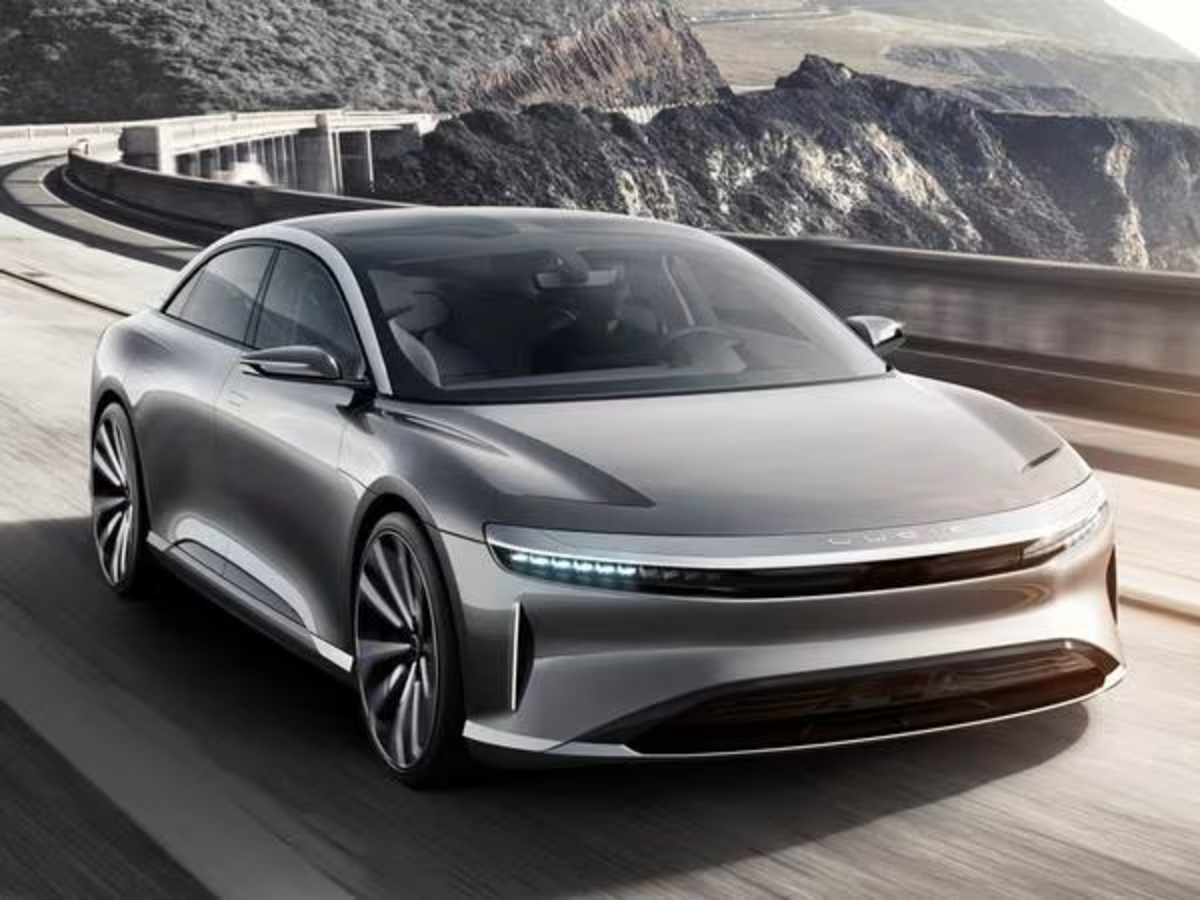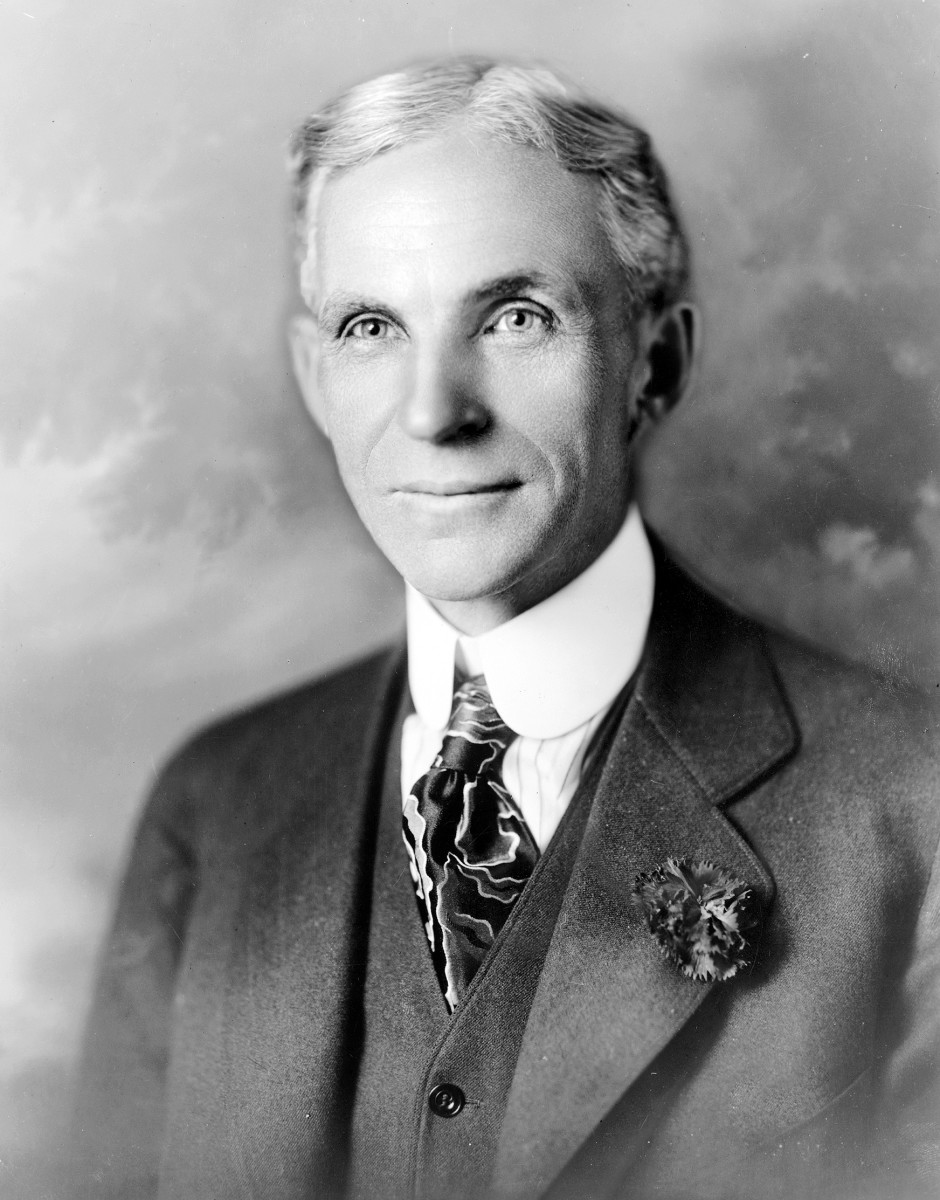'Make In India' Campaign= The government's move to woo automobile investors and job seekers alike
A close snapshot of India's automobile sector
- In 2013-14, 2.15 million vehicles were produced
- By 2015, Indian automotive sector will become the fourth largest in the world
- There are four large auto manufacturing hubs situated in India
- By 2020, India will sell 6 million plus vehicles annually
The Indian Prime Minister Mr. Narendra Modi has rolled out the red carpet for the foreign sector by launching a new campaign, entitled 'Make in India', to make India the booming manufacturing hub, in order to ignite both growth and job sector. Total 25 sectors have been identified by the government and among the list, automobile sector has received a mention. The new plan has received an immense applause form the automobile fraternity as many automotive sector giants are optimistic that the plan would augment the growth of the automobile sector. The move is likely to generate more jobs and growth opportunities for young people, and as a result, automobile sector will prove to be a thriving job generator in the near future.
Overall, it is a win-win situation for both investors and consumers.

Why should you invest in the Indian automotive sector?
« It is expected that by 2015, India will become the fourth largest automobile market by volume in the international arena.
« In the next five years, tractor sales in India are expected to increase at a CAGR (compound annual growth rate) of 8-9 per cent, making Indian marketplace a viable place for global brands.
« In the past seven years, two-wheeler production has increased from 8.5 Million units yearly to 15.9 Million units. More flourishing opportunities exist in the rural sector.
« By 2020, India's car market is expected to increase to 6+ million units yearly.
« The country has witnessed the emergence of large automotive clusters in India- Delhi-Gurgaon-Faridabad in the north, Mumbai-Pune-Nashik- Aurangabad in the west, Chennai-Bengaluru-Hosur in the south and Jamshedpur-Kolkata in the east. Moreover, many international players have decided to ramp up their investment plans in India in order to cater to burgeoning domestic demand. These manufacturers are judiciously leveraging India's competitive advantage in order to establish export-oriented production hubs.
The automotive sector of the country has received an overwhelming response from the government and as a result, various R&D (Research & Development) and NATRiP (National Automotive Testing and R&D Infrastructure Project) centers are established in the nation. Also, private players like Hyundai, Suzuki, GM are interested to set up an R&D base in the country. The Tata Nano is the excellent example of Indian engineering sector and is being recognized as the mobilizer of the young people. In the coming years, the share of electric cars is going to increase.
Pioneer agencies working towards the growth of the automotive sector in India are-
1= Department of Heavy Industries
2= Ministry of Heavy Industries & Public Enterprises
3= Society of Indian Automobile Manufacturers
Foreign Auto Makers' reaction on 'Make in India' campaign
1) We believe in 'Make in India' campaign. There are various factors that decide the Indian market. There is a huge potential for our cars here in India. The business atmosphere in the nation is quite good and favorable for manufacturing activity.
Hironori Kanayama, President & CEO, Honda Cars India Ltd.

There is an availability of good skilled manpower and there is a viable vendor network, which has the ability to meet the strict qualifications, cost & developer requirements of Honda and other top-notch companies. In this way, it has also encouraged to increase our localization levels of our cars- which will cross the mark of 90%.
xxxxxxxxxxxxxxxxxxxxxxxxxxxxxxxxxxxxxxxxxxxxxxxxxxxxxxxxxxxxxxxxxxxxx
B S Seo ( Managing Director & CEO - Hyundai Motor India Ltd)

2) Hyundai Motor India warmly welcomes the "Make in India" campaign by the new government working under the aegis of Prime Minister, Mr. Narendra Modi. Hyundai Motor India is the largest exporter and the second largest domestic car manufacturer. The company has been exporting its top-notch products to more than 100 countries by following the excellent manufacturing facility benchmarking global quality norms. The company will continue to be committed to the booming Indian market. We are fully convinced that the country has the potential to emerge out as the leading manufacturing hub in the near future.
xxxxxxxxxxxxxxxxxxxxxxxxxxxxxxxxxxxxxxxxxxxxxxxxxxxxxxxxxxxxxxxxxxxxxxxxx
Sumit Sawhney - Country CEO & MD Renault In India
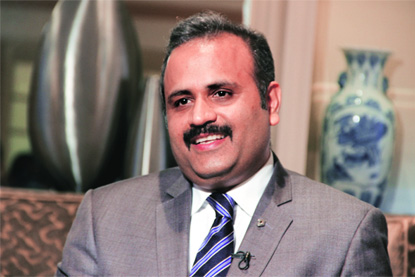
3) "The 'Make in India' campaign is a great move taken by the Indian government for the Indian manufacturing industry. What makes it impeccable is the aim to ease business processes in India, with promising reforms and favorable policy intervention which will surely attract foreign direct investment (FDI).
The automotive sector is the major contributor to the nation's GDP and it is encouraging that it will become the part of the 25 thrust sectors. I am pretty sure that such pro-business measures will help the manufacturing sector, led by the automotive sector, to bounce back stronger and deliver on its capability of becoming one of the largest and most efficient regions in the global arena.
Moreover, the formation of a stable government has produced abundant optimism for progress; and we are already witnessing a massive rise in macro-economic factors, including GDP, rise of the stock market and measures to combat inflation. The Make in India campaign will help building this momentum and will make India a true manufacturing powerhouse.
xxxxxxxxxxxxxxxxxxxxxxxxxxxxxxxxxxxxxxxxxxxxxxxxxxxxxxxxxxxxxxxxxxxxxxxxx
Do you think 'Make in India' campaign will create more automobile jobs?
Anoop Prakash, Managing Director Harley-Davidson India

4) We have started our operations in India in 2009 and recently we have started exporting to Europe and Asia. Our US-India success story was formulated with the young and talent partners, which we found in India, who diligently uphold and advance our top quality standards every day. Now, as the Prime Minister has launched an action oriented plan, it will also ease the business process and more importantly, it will inspire other companies to have a close look at India.
In 2013-14, the domestic market share:
Type of Vehicle
| Domestic Market Share
|
|---|---|
Passenger Vehicles
| 13.59%
|
Two-wheelers
| 80.37%
|
Three-wheelers
| 2.60%
|
Commercial Vehicles
| 3.44%
|
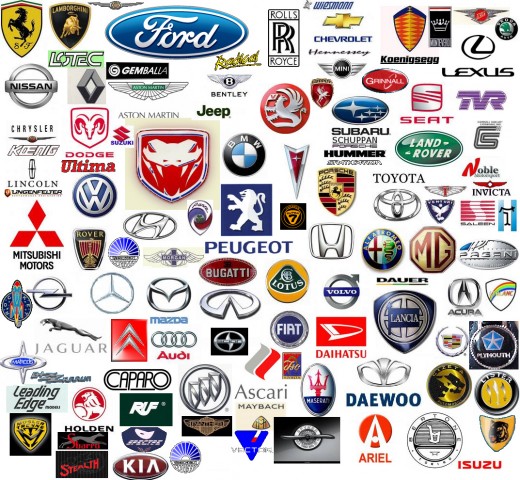
Vital statistics
- In the current scenario, the automotive sector is contributing around 7% towards the country's GDP and employing nearly 19 million people directly or indirectly.
- The auto sector is currently producing 2.15 Million vehicles, including passenger vehicles, commercial vehicles, three-wheelers and two-wheelers in 2013-14 in comparison to 2.06 Million in 2012-13, recording a growth of 4.04% in a year.
- By 2016, the Indian automobile sector is estimated to become one of the third largest in the global arena and will account for over 5% of the total global vehicle sales.
- India is the second largest two-wheeler manufacturer, the largest motorcycle manufacturer and also the fifth largest commercial vehicle manufacturer in the international arena.
- In 2010-11, the total turnover was USD 58.5 billion and it is expected that by 2016, it will increase to USD 145 billion.
- It is expected that between 2013-2020, passenger vehicles will increase at a CAGR of 16% between 2013-20.
- Between 2013-2020, two-wheelers and three-wheelers are expected to expand at a CAGR of 9%.
- A rising working population and middle class are expected to be the main demand drivers. GDP per capita has increased from USD 1,432.25 in 2010 to USD 1,500.76 in 2012, and by 2018, it is expected to reach USD 1,869.34.
- India accounts for world’s 12th largest number of high net worth individuals, with a massive growth of 20.8%, the highest number in top 12 nations.
The Indian automobile sector ranks 6th in the list of industries attracting foreign investment in the country
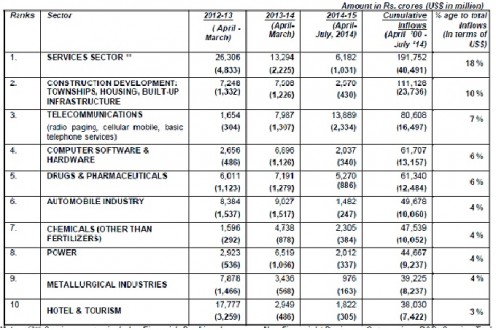
Where can you invest in the automotive market?
- Passenger vehicles- Utility cars, passenger cars, multi-purpose vehicles.
- Two-wheelers- scooters, motorcycles
- Three-wheelers- goods carrier, passenger carriers
- Commercial vehicles- Medium & heavy commercial vehicles, light commercial vehicles
Factors contributing towards the growth of the automotive sector
- In the past few years, there has been an increase in the disposable income in the agricultural sector.
- There is a presence of a vast skilled and semi-skilled employees and a viable educational system.
- There is a large number of items available to customers across diversified segments. After the entrant of foreign players and a reduction in the overall product life cycle, more products are launched in the market.
- The abundant availability of a wide gamut of vehicle models to meet rising needs and preferences.
- The availability of easy finance schemes has triggered the automotive sector growth in India. Due to the flexible finance plans, the auto finance sector has increased at the rate of 13% between 2008-13. Moreover, the car finance penetration has also increased between 68% - 70% between 2008-10 and between 70% - 72% in 2011-13.
- The government has unveiled favorable policies like automotive mission plans, reduction in excise duties, formation of NATRiP etc.
Automotive sector policy
- Automotic approval for foreign equity investment up to 100% without any minimum investment criteria.
- Manufacturing and import in the automotive sector are exempted from licensing and approvals.
- The government is offering rebates on R&D expenses and it will encourage more & more companies to establish their research centers.
In India, there is a huge demand of low-cost electric vehicles which are then suited for short-distance urban commuting. As per an estimation, total electric vehicle sales would reach to 6-7 million units by 2020.
1= Automotive Mission Plan, 2006-16
Objective of the Automotive Mission Plan, 2006-16=
- To emerge as the leading destination of design and manufacture of automobiles and auto components with output increasing to USD 145 Billion, accounting for over 10% of the GDP and offering additional engineering and auto components jobs to over 25 million people by 2016.
- The setting up of the technology modernization fund focusing more on small & medium enterprises.
- The set up of automotive training institutes and auto design centres, special auto parks and auto component virtual special economic zones.
The second version of the automotive mission plan 11 for the tenure of 2016-26 is under preparation and it will get finalized by mid 2015.
2= National Automotive Testing and R&D Infrastructure Project (NATRiP)
Backed with an investment of USD 388.5 million, the project would help auto industry to adopt and implement international performance standards. Moreover, its main focus is on imparting low-cost manufacturing and product development solutions.
3= The National Mission for Electric Mobility 2O2O
This apex body works towards encouraging affordable, reliable and efficient hybrid and electric vehicles that meet customer's performance and price expectations through various government initiatives-industry collaboration, for the encouragement and promotion of indigenous manufacturing capabilities, consumer awareness and technology – thereby helping India in becoming the leader in both two-wheeler and four-wheeler hybrid and electric vehicles market in the world map by 2020.
Other pivotal electric vehicles projects
-
The Department of Heavy Industry (DHI) has unveiled a pilot projects on electric vehicles in Delhi and subsequently, other cities across the country under the NEMPP 2020 with the purpose – demonstrating advantages of adopting cleaner, greener modes of transportation and also exploring viable operational modalities.
-
Moreover, DHI has decided to impart viability gap funding through subvention to encourage extra cost of acquisition and operation of these vehicles by state governments or other bodies. In its first phase, a pilot project to give the last mile connectivity to the Delhi Metro through electric passenger vehicles, has been sanctioned. All other states have appointed the nodal officers to co-ordinate with DHI and vehicle manufacturers for implementing the pilot projects in their territory.
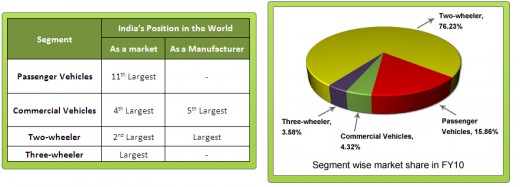
Financial Support
Tax benefits under the Union Budget 2014-15
The government has exempted the excise duty on parts of tractors which are moved from one or more factories of the tractor manufacturer to the other factory of the same manufacturer.
Assesses are allowed to claim benefits under any of the below deductions-
Investment allowance (additional depreciation) at the rate of 15 per cent for those manufacturing companies who invest over Rs 1 billion in plant & machinery acquired and installed between 01.04.2013 and 31.03.2015, provided the total investment in new plant & machinery during the aforementioned period is more than Rs 1 billion.
Moreover, to give a further benefit to companies which are engaged in manufacturing, an extra deduction of 15% on the cost of new plant and machinery is extended for investments, more than Rs 250 million.
The lower excise duty on automobiles, given in the interim budget, has been raised till December 2014.
- In case of small cars, motorcycles, scooters – the duty has been lowered to 8% from 12%.
- For commercial vehicles and SUVs – the duty has been deducted to 24% from 30%.
- n case of large and mid-segment cars – the excise duty has been reduced to 24% from 27% and 20% from 24% respectively.
Some other perks offered by the Union Budget 2013–14 are detailed below-
The government has extended the term of concession available for a particular part of electric and hybrid vehicles – April 2013 up to March 31, 2015.
An exemption will be given to the manufacturers of lithium ion automotive battery packs, which are then supplied to manufacturers of hybrid and electric vehicles.
For the R&D incentives
Industry/private research programs= A weighted tax deduction is provided under section 35 (2AA) of the Income Tax Act. Also, a weighted deduction of 200% is given to assess for any amount paid to a national laboratory, university or institute of technology, or specified persons, provided that the amount is used only for the scientific research within a program permitted by the competent authority.
Companies who are engaged in the manufacturing of an in-house research & development center= Under the section 35 (2AB) of the Income Tax Act, a weighted tax deduction of 200% for both capital and revenue expenditure incurred on various science research and development activities. However, expenditures incurred on land and buildings are not entitled to get the deduction.
For manufacturers of batteries which are used in electrically operated vehicles, concessional excise duty of 6% has been extended up to 31st March, 2015.
There is an exemption from basic customs duties on lithium-ion automotive batteries, which are then used in the manufacturing of hybrid and electric vehicles.
Leading players in the Indian market
Nissan (Japan)
Suzuki (Japan)
Piaggio (Italy)
Renault (France)
Volkswagen (Germany)
General Motors (USA)
Hyundai (South Korea)
BMW (Germany)
Toyota (Japan)
Ford (USA)
State incentives
Each state in India is offering additional incentives for various industrial projects. Incentives, like rebates, cost, relaxation in stamp duty, power tariff incentives, a concessional rate of interest on loans, tax incentives, special incentive packages, etc., are offered for various projects.
Area-based incentives
The government offers incentives to companies who set up their projects in special areas like Jammu & Kashmir, Northeast and Himanchal Pradesh.
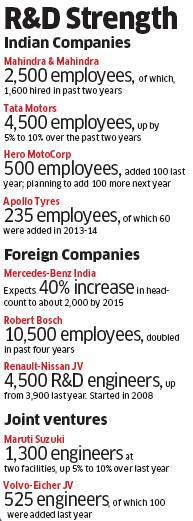
An upsurge in the employment sector
The massive growth in the automobile sector has ignited the job market, where there is a great demand of people in the automobile engineering field also. Moreover, as the government has now become more liberal towards the automobile sector, therefore, new players have made their entry into the Indian automotive sector, which has made the field both challenging and competitive. As a result, there has been a significant rise in the number of jobs available in the automotive & manufacturing field. According to a survey by MyHiringClub, around 39% growth has been recorded in the automobile & manufacturing field in the past few years.
In fact, Mr. Mahesh Kodumudi, Volkswagen India chief representative, president and MD, said that it is a great campaign launched by the Indian government to promote country's manufacturing sector, which will surely prove to be beneficial for both investors and people. Our company will play its part by bringing in more new investments and create high value automobile, chemical engineering, civil engineering & manufacturing jobs to cater the needs of the Indian market.
Global car makers are moving their R&D work to India
In the past few years, the trickle of foreign R&D professionals into the Indian auto sector has increased to a great extent. Companies like Foton, BMW, Maruti Suzuki, Mercedes, Renault-Nissan and Volvo have also set up their R&D centers in the country. These companies are moving their work back to India to tap the engineering base and cost advantage of the country. As a result, there is a high demand of research analyst, marketers, chemical engineers, mechanical engineers, etc., in this field.
References:
http://auto.economictimes.indiatimes.com/news/passenger-vehicle/cars/foreign-auto-makers-reaction-on-make-in-india-campaign/43487159
http://www.makeinindia.com/sector/automobiles/
http://auto.economictimes.indiatimes.com/autologue/Impact-of-Make-in-India-campaign-on-Auto-sector/339

